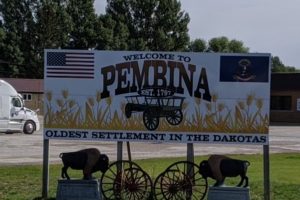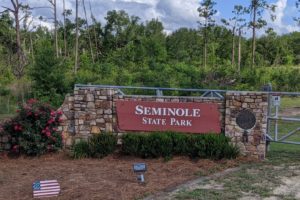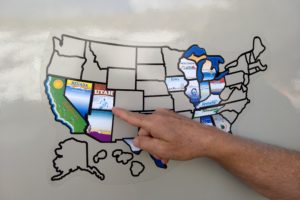The town of Okeechobee is a nice-sized small town with a 2020 population of 5254. Whenever we go to a new town, we always start with the chamber of commerce or visitors center. This was a great place to get the information we needed for learning about the town.



The city was incorporated on June 4, 1915, and the city hall was built during the “Boom Years” in 1926. The design and construction shows a Mediterranean Revival style popular during the great land boom of the 1920s.
murals
While the book took us to the sites of many of the historical places, most were no longer standing so we’ll just concentrate on the murals that show the city’s history.




It depicts activities within the bank building in 1923, along with other businesses that occupied the building during 1924-1950. The bank went bust during the 1926 downturn and then housed the Hunt Brothers grocery. Now the Culbreth Family has renovated the building as a venue for their family.



city parks
The city has 5 parks that follow each other along Main Street.



1521 – cattle history
In this year, Juan Ponce de Leon brought a small herd of Andalusian cattle and horses with him on his 2nd expedition to the New World–these were the first cattle and horses to ever set foot (or hoof) on what is now the continental United States.

1700s – Throughout these years, Native Americans who eventually became known as the Seminole Tribe played in a growing and sustaining early cattle ranching.
late 1700s and early 1800s – Settlers of British descent became known as Crackers moved into Florida during these years. They began to round up the wild Spanish cattle to form their own herds, which became known as Cracker cattle, the foundation of Florida’s cattle industry. With these animals running wild in the woods, all the Crackers had to do to make them their own was to catch them and brand them.
Interesting how our perception of the word Cracker has changed over the years.
Wars provided an economic boost for Florida cattlemen who provisioned armies during the Seminole, Civil, and Spanish-American Wars.
1864 – The Civil War disrupted trade with Cuba, but Florida cowmen became beef suppliers to both the North and the South. During the next 3 decades, trade boomed with Cuba, Key West, and Nassau. Florida became the nation’s leading cattle exporter.
1900s – Lots of changes happened in the next century and ranchers turned from Cuba to domestic markets. As early as 1858, ranchers attempted to improve the quality of their herds with Brahman cattle originally from India. Since the 1930s, ranchers have cross-bred native cattle with Braham, Angus, and Hereford to improve size, resistance to heat, hardiness, and meal quality–leading to development of hybrids breeds.
After 500 years, cattle ranching in the state grew from small, family-owned herds to large-scale operations that are integral part of Florida’s culture. Multi-generational family ranches have cared for the land, provided employment for many residents, and continue to be good “stewards of the land.”
1700s – more history of Seminole cattle ranching

For centuries, the Seminole Tribe in Florida have been expert cattlemen and an important part of Florida’s cattle ranching history and industry. The first recorded participation in organized cattle ranching by the Seminole Tribe happened in the 1740s. After the Spaniards left Florida, the remaining wild herds of beef cattle were gathered by the Seminole communities. These native Americans had numerous conflicts against European-American frontier settlers, resulting in many land disputes over cattle grazing for access.
By 1775 a prominent leader called Cowkeeper built a community in the Oconee Creek region and created the largest settlement of the time in Florida.
1800s – Civil War influence
During the Civil War, the area experienced a mad dash of collecting wild cattle, ushering in the age of the cattle rustler. Theft of cattle began to skyrocket with the post-Civil War demand for food and resources.
The Seminole Tribes in the area continued to raise cattle while fighting off pressure and violence from rustlers. The Seminole Tribe and Florida Cracker Cowboys worked together to deter these cattle rustlers. Cracker ranchers frequently chose to hire Seminole cattlemen because they knew the country so well and were experts with cattle herding. The Seminole cattlemen knew the best pastures and how to rotate herds to optimize beef production.
1900s – associations created
In 1939, the Indian Livestock Association was created. In 1944, the Seminole Tribe created separate ranch operations in areas around here. Today the Seminole Tribe is recognized as one of Florida’s leading beef producers. Using video auctions, other tribal cattle herds are promoted across the country for sale. The communities worked together for mutual economic benefit for the Florida Cattle Industry.
branding cattle became a ranching tradition
Branding livestock, especially cattle, has been a tradition for thousands of years to identify the owner, especially before fences separated herds. Branding also deterred cattle rustling and returned rustled animals to their rightful owners.
Law-abiding ranch hands kept hand-written and carefully illustrated “brand books” to help identify and sort their cattle. Today brands are required to be registered with the state.


a cowboy’s best tools
A cutting horse is a stock horse that’s been bred and trained for cutting, the ability of a horse and rider to separate a single cow from a herd of cattle and prevent it from getting back to the herd.
By the late 1800s, cattle trading was an industry, making cutting horses as indispensable tool of the trade for ranch hands. Large herds of cattle grazed freely on the open ranges, and strays wandering off would typically join the herds of other cattle ranchers. Such mixing of herds make cattle roundups an annual or semi-annual routine. Cowhands kept a herd of horses that ranch hands could select their mounts from whenever they traveled. Some horses had specialized skills so the cowboy had the right horse for the assorted herding jobs.
Horses with a unique awareness of cattle, a kind of wariness with ears perked and eyes focused on the heard, were elite members of these groups of cutting horses.

Cutting horses on today’s ranch are still considered a cowboy’s invaluable tool. They are quick, agile, have a great instinct for how cows behave, and assist their riders with the cattleman’s duties. By working closely together, the cowboy and horse build a strong bond of loyalty and respect. They are the pride of a cowboy. [If you’ve watched the Yellowstone series you’ve seen the quick work that these cutting horses can do.]
Florida cowmen depend on a good cow dog. The first stock dogs came to Florida by Hernando De Soto in 1539. He and his explorers came here by ship and brought with them some cattle and herding dogs. By the time of the pioneer cowmen, many mixed breeds of cow dogs were available, primarily of the hound dog, bulldog, cur, leopard, or Australian Blue Heeler breeds.
These dogs saved the cowmen time and miles because they could chase runaway cattle. Some of these dogs are called catch dogs because they’ll hold a cow by the nose, ear, or leg until the cow is roped. Never will they bite or harm the cattle. These spirited dogs will go face-to-face with a bull and stand their ground. When not out cow hunting, they serve as family watchdogs and protectors of the homestead.


What an interesting look at Florida’s history and culture today. So different from what we’ve seen along the coasts.





Leave a Reply
Your email is safe with us.